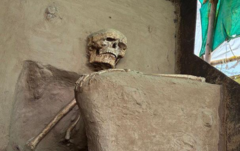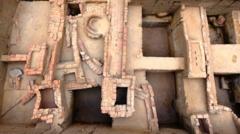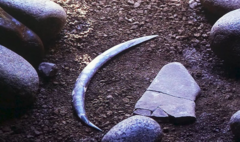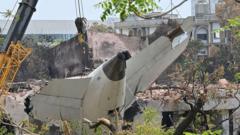For six long years, a 1,000-year-old skeleton discovered in Vadnagar, India, has been without a museum to call home, as authorities bicker over ownership and proper procedures for its display.
Ancient Skeleton Left in Limbo: India's Quest for a Permanent Home

Ancient Skeleton Left in Limbo: India's Quest for a Permanent Home
A significant archaeological find in Gujarat remains without a permanent resting place due to bureaucratic hurdles.
The skeleton, found in a meditative posture buried in a grave, is believed to be from the Solanki dynasty, which ruled parts of Gujarat from 940 to 1300 CE. Discovered by archaeologist Abhijit Ambekar during excavations in 2019, the well-preserved remains offer valuable insights into the region's historical and cultural narrative. Despite the skeleton's archaeological significance, it is still housed in a makeshift shelter, approximately 300 meters from a newly opened Archaeological Experiential Museum, that does not include the skeleton among its displayed artifacts.
According to Ambekar, while local officials have attempted to transfer the skeleton to a proper museum, bureaucratic red tape has delayed this process. As things stand, the Gujarat government claims the skeleton is still under the Archaeological Survey of India's (ASI) care, citing improper protocols were followed during the transfer of the find. However, local authorities assure the public progress is being made toward its eventual relocation.
The skeleton's burial posture suggests it may represent the ancient practice of "samadhi burials," where revered figures were interred rather than cremated. Initial scientific analysis indicates the skeleton was that of a local man in his forties, although further studies are necessary to understand more about his lifestyle and diet.
Currently, the skeleton remains exposed to natural elements, prompting community outrage over its treatment. Local citizens emphasize the potential historical and economic benefits that could arise from appropriately showcasing the skeleton. The indecision over its fate has sparked conversations about the effective management of cultural artifacts and the need for streamlined processes to ensure that historical treasures are preserved for future generations.
As pressure mounts for a resolution, many from Vadnagar echo the sentiment that this important piece of history deserves more respect and protection, urging for the bureaucratic delays to be eliminated to give this unique relic the permanent home it has long awaited.
According to Ambekar, while local officials have attempted to transfer the skeleton to a proper museum, bureaucratic red tape has delayed this process. As things stand, the Gujarat government claims the skeleton is still under the Archaeological Survey of India's (ASI) care, citing improper protocols were followed during the transfer of the find. However, local authorities assure the public progress is being made toward its eventual relocation.
The skeleton's burial posture suggests it may represent the ancient practice of "samadhi burials," where revered figures were interred rather than cremated. Initial scientific analysis indicates the skeleton was that of a local man in his forties, although further studies are necessary to understand more about his lifestyle and diet.
Currently, the skeleton remains exposed to natural elements, prompting community outrage over its treatment. Local citizens emphasize the potential historical and economic benefits that could arise from appropriately showcasing the skeleton. The indecision over its fate has sparked conversations about the effective management of cultural artifacts and the need for streamlined processes to ensure that historical treasures are preserved for future generations.
As pressure mounts for a resolution, many from Vadnagar echo the sentiment that this important piece of history deserves more respect and protection, urging for the bureaucratic delays to be eliminated to give this unique relic the permanent home it has long awaited.





















